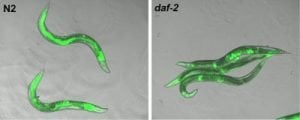The results of the study may bear significance in the treatment of Alzheimer’s disease and cancer.
Dysfunction of the ubiquitin-proteasome system is related to many severe neurodegenerative diseases, such as Alzheimer’s and Parkinson’s diseases, and certain types of cancer. Such dysfunction is also believed to be related to some degenerative muscle diseases.
The proteasome is a large protein complex that maintains cellular protein balance by degrading and destroying damaged or expired proteins. The ubiquitin is a small protein that labels proteins for destruction for the proteasome. If the system does not work effectively enough, expired and damaged proteins accumulate in the cell. If the system is overly active, it destroys necessary proteins in addition to unnecessary ones. In both cases, cell function is disturbed, and the cell may even die.
Proteasome activity is believed to decrease with ageing. However, not much is yet known about how proteasome activity is regulated in an aging multicellular organism. The research team of Academy Research Fellow, Docent Carina Holmberg-Still has discovered an important proteasome regulatory mechanism. The study was published in Cell Reports, a highly esteemed scientific journal.

“We examined whether proteasome activity is affected by insulin/IGF-1 signalling [IIS], which regulates aging in many organisms. The results show that decreased IIS increases proteasome activity,” says Holmberg-Still.
Proteasome activity was studied in C. elegans, a free-living roundworm. Decreased IIS increases proteasome activity through the FOXO transcription factor DAF-16 and the UBH-4 enzyme. DAF-16 represses the expression of ubh-4 in certain cell types. The ubh-4 enzyme slows proteasome activity, which means that its repression accelerates proteasome activity.
“Using a cell culture model, we proved that the same mechanism works in human cells,” says Holmberg-Still. When the expression of the uchl5 enzyme – the human equivalent of ubh-4 – was decreased, proteasome activity and the degradation of harmful proteins increased.
“Our study shows that the effect of ageing and the related signalling pathway on proteasome activity is tissue-specific. This was a new and interesting discovery that bears great significance in terms of treatment opportunities,” says researcher Olli Matilainen, who prepared his dissertation in Holmberg-Still’s research team.
The identification of proteins that regulate proteasome activity and an understanding of the regulatory mechanism offer new opportunities in treating diseases that involve proteasome dysfunction. According to Holmberg-Still, proteins that regulate proteasome activity are particularly interesting in terms of medicine development.
“An ability to accelerate proteasome activity could be beneficial in the treatment of neurodegenerative diseases. Targeted proteasome inhibitors would be useful in the treatment of cancer – general proteasome inhibitors are already used as cancer medication to some extent, but they often have harmful side effects, because they cannot be targeted to a specific tissue.”
Holmberg-Still’s team continues to investigate tissue-specific mechanisms that regulate proteasome activity. The team collaborates with clinical researchers to confirm whether its research results can be refined for clinical use.
Notes about this proteasome activity and neurodegeneration research
Contact: Dr. Carina Holmberg-Still – University of Helsinki
Source: University of Helsinki press release
Image Source: The Proteasome Activity Was Studied in C. elegans image is credited to Dr. Carina Holmberg-Still and is adapted from the University of Helsinki press release.
Original Research: Full open access research for “Insulin/IGF-1 Signaling Regulates Proteasome Activity through the Deubiquitinating Enzyme UBH-4” by Olli Matilainen, Leena Arpalahti, Ville Rantanen, Sampsa Hautaniemi and Carina I. Holmbergin Cell Reports. Published online June 27 2013 doi: 10.1016/j.celrep.2013.05.012







